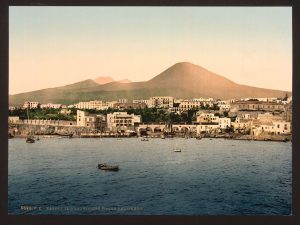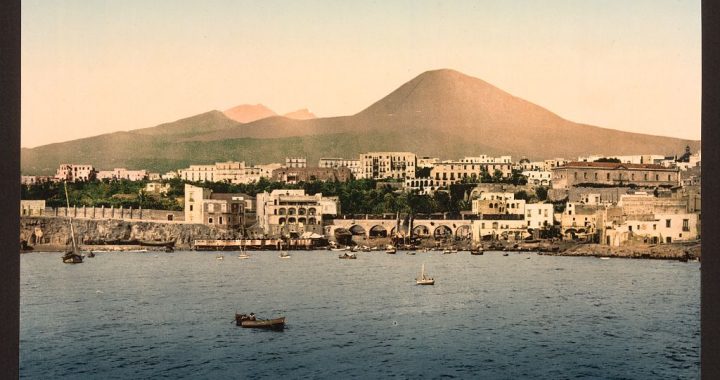The Genesis of the United Church of God
A Personal View from Ground Zero
Humbling and exciting was a personal tenor for me in the early 1990s. The wide-reaching organization that I considered a privilege to be a part of was growing. It had not only survived the death of its human founder a few years earlier, it was thriving. I counted myself fortunate for the humbling opportunity to serve, having experienced a broad spectrum – from ministerial trainee to a pastor serving multiple congregations to senior administrator, the latter a position I had never sought.
But no one could have predicted what was about to unfold. A spiritual and organizational catastrophe was rumbling under the surface, concealed out of sight to more than 120,000 members.
In retrospect, one might draw a comparison to the beautiful Roman cities of Pompeii and Herculaneum in A.D. 79. Some 20,000 people living the idyllic cities on the Gulf of Naples in Italy were caught off guard, even though unusual and alarming tremors were increasing in tempo and magnitude. The two cities suffered unexpected devastation by the eruption of Mount Vesuvius, which 4,200 ft. peak loomed over the region.
The shock to the populace was terrifying. The eruption unleashed a cataclysmic force, ejecting a roaring cloud of volcanic superheated gas and smoke nearly 12 miles into the sky. Spewed out of the erupting volcano, deadly waves of gas, ash, and rock tore mercilessly towards Pompeii and Herculaneum at speeds exceeding 400 miles per hour.
Within moments, the cities were buried under relentless layers of hot volcanic ash and pumice, preserving the forms of the victims and their environs for almost 2,000 years, serving today as a haunting memorial. It wasn't until the 18th century that archaeologists began to unearth the Pompeii site, revealing a society that truly had been caught off guard by overwhelming seismic forces.
Looking back some 30 years ago, these sobering details seem familiar. In those days, our former fellowship was crippled by a spiritual catastrophe of Pompeii-like devastation. Thousands of lives were unended, once-solid faith shattered, vital trust annihilated, relationships vaporized.
The once-vibrant work, reflected in broad scope and impact on national and international media -- together with many hundreds of congregations and multiple thousands of brethren gathering for worship each Sabbath, was all but buried, with little remnants working to pull themselves out of the devastation, to try and reorganize, and survive.
Today we can do a little spiritual archaeology and review somberly what happened.
Like Pompeii, the looming devastation was signaled in advance by a series of tremors and earthquakes. The same was true for the once-vibrant Worldwide Church of God. In this chapter of Ground Zero, let’s review the spiritual and organizational seismic activity that preceded the blowup and collapse of our former fellowship.
Tremors
Few, if any, truly anticipated the scope and rapid downfall and disintegration of the Worldwide Church of God. We were after all an organization with a substantial following, outreach, and a caring pastoral support system. We lived in a country whose Constitution protected our right to freely preach the Bible without incrimination.
As I have previously noted, at age 18 and newly converted from the Ukrainian Orthodox faith, I went to Ambassador College in Pasadena California, transferring to the Ambassador College campus in Bricket Wood, England. Fortunate to become part of the ministry of Jesus Christ in 1969, in 1990, I found myself and my wife Beverly at the physical international Headquarters of our Church, playing an unexpected role in the management team of the Church Administration department.
As has been covered earlier (see former chapters for details) the person serving as head of the ministry under his father, Joe Tkach Jr., appointed me to the Manuscript Review Team (MRT). This team was responsible for reviewing literature that we provided to the public to ensure accuracy, style, and relevance.
After a year of service there, Joe Jr. added me to the Church’s doctrinal team. That was a humbling appointment.
Members of this group included a number of then-senior ministers, many of whom held evangelist rank (as the church once demarcated ministerial ordination levels) and were considered “A-listers” in the organization.
Here are the names of the senior ministers, all very familiar to me, but perhaps not so much to others today in the second decade of the 21st century: Joe Tkach, Jr., Mike Feazell, Greg Albrecht, Bernie Schnippert, Herman Hoeh, Randall Dick, Ron Kelly, Larry Salyer, Kyriacos Stavrinides and by teleconference from the Ambassador Big Sandy campus: Donald Ward and Leon Walker. This is the senior group that was mostly in attendance in the weekly meetings. There were others, as well.
The MRT and the doctrinal group worked together. Manuscript review often led to doctrinal inquiry. The leader of both these groups was Mike Feazell, Joe Tkach Sr’s assistant.
I think it is important to note that despite the magnitude of what was being discussed in these groups, Mr. Tkach himself never came personally to any of the meetings. That was an important, but perhaps underappreciated, first tremor.
A second tremor rumbled as the highly influential Mike Feazell began studying theology at Azusa Pacific University, a conservative evangelical college some 15 miles from Pasadena. Azusa Pacific’s seminary focuses on Wesleyan-Arminian doctrinal theology and is thoroughly trinitarian. Soon, what Mike was learning was finding its way into our formal discussions.
When these groups met, we at first found ourselves reinvigorated as we delved into familiar doctrines. My hope was that we could strengthen our explanation. In this process we faced probing and insightful questions.
Our team reviewed hermeneutics which are the principles guiding our study, research, and interpretation of the Bible. This aspect of our investigation proved enlightening and reaffirmed our dedication to understanding and applying biblical teachings accurately.
I was secure that the beliefs that the church had researched, tested, and taught over decades could and would be further biblically buttressed. Certainly, we were in good hands at Headquarters with all of these theological all-stars. I thought and earnestly believed that this process was critically important for a number of reasons.
Like many others, I didn’t notice or fully appreciate the mild organizational tremors that were occasionally rumbling through these meetings.
One of the first projects we worked on was to draw up a synopsis of our Church’s doctrines. In our recent history, there was not one single document that summarized the main tenets of our faith. By 1993 we did produce a booklet entitled Statement of Beliefs. Later when the United Church of God was founded, this edition of the booklet became the guide for the Fundamentals of Belief publication. The first doctrine summary was “God” as revealed by the Father, the Son, and the Holy Spirit. This is how United Church of God’s Fundamentals begins as well.
Shortly after the publication of the Statement of Beliefs I travelled to Sabbath-keepers in Ukraine on one of my visits. We had many beliefs and practices in common notably the seventh day Sabbath. On our visits we always spent time discussing our common beliefs. This time I presented them with the newly published Statements booklet which they enthusiastically reviewed.
They made an observation about our first doctrine which was about the nature of God. They had some helpful insights. They remarked that as far as biblical teachings went, we could improve our understanding and expressions of the work of the spirit and its role in our lives.
While God uses personages to reveal the Father and the Son, He does not do so with the Holy Spirit. We try to define an omnipotent, omnipresent, and omniscient God with unlimited dimension that we do not grasp with our limited human capacity.
Soon afterwards, I returned to Pasadena. Usually, in our meetings, as a junior member, I did not say much that caused much reaction or stir, but this report to some members of the doctrinal members team did. It triggered some unexpected reactions. Some of them latched on to the idea that we did not do enough with the Spirit of God.
I related that to understand the context of the Ukrainian Sabbath-keepers, we needed to understand that these people had gone through decades of extreme religious persecution from oppressive godless Communism. They spoke of how God, through the workings of the Holy Spirit, protected them from the KGB and the police, allowing them safety. They experienced miracles to be able to worship Him where it was forbidden to meet. Those experiences were a far cry from what the doctrinal team experienced personally in Pasadena.
In our doctrinal discussions in the beginning, I felt that we all were committed to be honest about our inquiries. We agreed that if we found compelling evidence and reached a respectful consensus, we should be open to elevating our beliefs and teachings. That was not without then-recent precedent in the history of the Worldwide Church of God.
For example, in 1974 and later, the Church arrived at biblical understanding that led to changes in the observance of Pentecost, certain doctrines regarding remarriage, and the position of seeking professional medical resources within the scope of the church's healing doctrine..
We didn’t appreciate it at the time, given the vast respect then for our current body of theological knowledge and belief, but a deep spiritual tremor was starting to rumble in a now-recognized ominous way.
Here’s how that played out. Our discussions as a doctrinal team were at first collegial and respectful. Voices of scholarship and experience were valued. But as the weeks of meetings continued, our talks now were moving beyond making technical corrections and adjustments based on incomplete or flawed evidence.
A new tremor magnified into a small earthquake: we were now moving into the spiritual muscle, bone, and DNA of who we were as a Church.
Mike Feazell would bring up various subjects, discuss them, and set them aside and then circle back to them later. Several topics came up including the keeping of the Sabbath, the Law of God, and the greatest topic of all – The Nature of God.
Seismic Shift
Prior discussions on the subject of the Sabbath shifted dramatically. Topical review steered away from how Christians can better respect and keep the Sabbath day.
Then, the first real temblor hit hard: the discussion about the Sabbath veered off. Open comments appeared about the spiritual validity of the Sabbath and its applicability to us in the first place. This was a seismic shift and caused us to seek stability to hang on to keep from losing our balance.
While I was a junior member of that team, I firmly thought and held that for all intents and purposes we were correctly keeping the Sabbath as Christ and the apostles, and the early church kept it. And I believed that was the right thing to do! There was nothing new in these counterarguments.
Another spiritual temblor rocked the team when the writings of liberal scholars such as Australian Seventh Day Adventist Robert Brinsmead were presented. Brinsmead was founder and editor of Present Truth magazine. In the late 1970s, Brinsmead questioned and discarded many of the doctrines that he previously believed in. He concluded that the Sabbath was given for Israel as a “shadow of things to come,” but that it was fulfilled by Christ, the substance. The spiritual earth rolled under our feet. A direct path to abolishing the Sabbath was clearly emerging.
One minister I spoke to who at first was enamored by Brinsmead’s writings told me that reading his material was like going down a river where the water was turning to rapids with a waterfall ahead. He told himself: “I better head for shore now before I go over the falls.”
Randall Dick, in our discussion group loudly defended our keeping the Sabbath and spoke passionately about how it was observed in their family and the sacrifices their children made to obey God and dispense with Friday night and Saturday school sports. I remember the reaction of Greg Albrecht in the meeting which was an uncaring shrug of the shoulders and a few meaningless words.
In addition to multiple tremors, hot sparks were beginning to eject out of the Pasadena Vesuvius. As they landed and smoked in the increasingly open theological landscape, people started to notice. They were alarmed at the theological brush fires that started flaring up.
Soon, rumors started to fly that the Church was “doing away with the Sabbath.” Joseph Tkach’s office denied these rumors. As then-Pastor General, what Mr. Tkach did not know was that these rumors were true! They originated from people at HQ who shared this information with ministers in the field.
As news of some of our discussion agendas leaking into the field ministry, alarm bells went off: "They're planning to do away with the Sabbath!" We had a good idea that this leak was deliberately planted by the doctrinal discussion group leaders themselves. Once out, this change would force the hand of the administration.
In later post-crisis commentary, some of the group leaders have tried to characterize the doctrinal changes as some kind of “change management initiative.” If it was, it was deeply flawed by the subversive and deliberate “leaking” of confidential information to politically position and force costly change. Such actions violated the critical collaborative principles of professional change management and doomed the initiative to abject failure
When Mr. Tkach Sr, was getting wind of the rumors he would lash out at those who were spreading such information. He would refer to it regularly on his field visits to churches in the United States. Spiritual tremors and escalating earthquakes were increasingly in frequency and magnitude. The Church environment was becoming unsettled. We were moving from construction to deconstruction fast. From revelation to revolution.
One day Mr. Tkach came down to my third-floor office in the Hall of Administration and sat down to chat. Both Joe Jr. and Mike Feazell were out of the country for a ministerial conference in Australia. Mr. Tkach and I had a good relationship and now he felt free to just talk.
As we talked, Mr. Tkach remarked how he was disturbed about many things. Recent unsavory trends included a sharp drop in the Church’s income and a decrease of membership and Sabbath attendance. The Plain Truth magazine had now taken on a less interesting format. As income flattened, The World Tomorrow television program – once the top-Nielsen ranked religious program – had been cancelled. The decision was essentially unilateral. Church members were puzzled, even increasingly alarmed.
The once-powerful global voice of the Gospel was being silenced.
I tried to respectfully tell him about the factors that were contributing to this disturbing malaise from my point of view. We discussed the rumors of major doctrinal change that were circulating around the country.
He knew about the rumors but didn’t seem to know the source. I decided to take a major risk. I point blank told him that the rumors were emanating right from the building we were sitting in. He seemed shocked.
I was personally incredulous that he was so far out of the loop. At the time, I really felt bad for him and the Church.
As he rose to leave, Mr. Tkach emphasized that he would personally address all this directly with Mike and his son Joe right after they returned.
I never heard another word about this again. It was as if our conversation had never happened.
Meanwhile, the tremors continues to magnify in force, shaking the spiritual ground around us. Our discussion meetings continued and the bias towards deconstructing our doctrines was in full force. Now, shocking mockery and sarcasm of who we were emerged.
I couldn’t stomach this. My attendance to these once-exciting meetings became irregular.
The truth? My mindset of defending the faith once delivered was not welcome. One of the group, Larry Salyer, actually asked to be reassigned from Pasadena to a church in the field. He had had enough.
One day I asked Mike Feazell directly: “Mike, where is the bottom to all this?” His sharp retort with piercing eyes to me was “There IS no bottom!”
This was a change from the collegial brotherly atmosphere to a vast and toxic gulf opening between those who had no idea about where this was going and with those who knew exactly where this was going.
I told him another time sometime in the future, maybe fifteen years from now, people will mock us as we are mocking them. His response was angry: “And I hope they do!” More than twice that time has passed. What has occurred is a kind spiritual Holocaust or the Holodomor engineered by leaders who couldn't care less about the humanity that perished.
I honestly warned them that this would happen. The tremor that almost knocked me off my feet was the fact that doctrinal leaders savaging established belief couldn’t care less what it was doing to the many, many thousands of people whose lives were being turned upside down by the very people whom they trusted.
There is a saying circulating attributed to a Communist demagogue: “One death is a tragedy; one million deaths are a statistic.” I felt that the betrayed and buried in WCG were swiftly becoming the latter.
The spiritual tremors were now temblors, knocking over everything in their path.
The path of spiritual deconstruction widens in the next chapter of Ground Zero.

